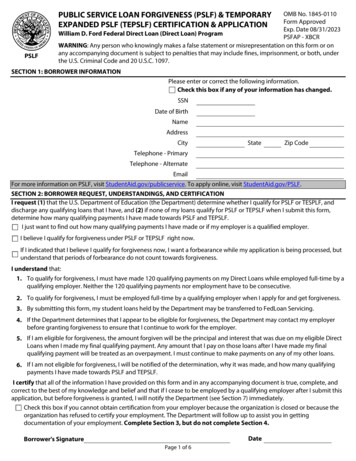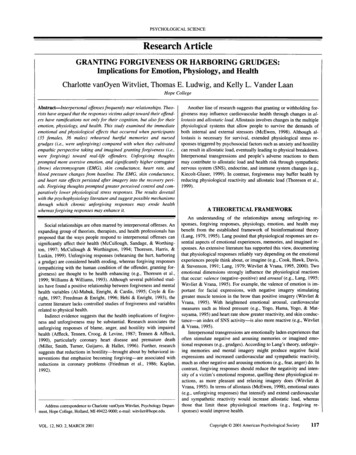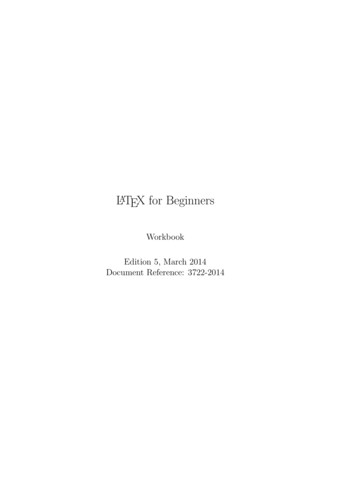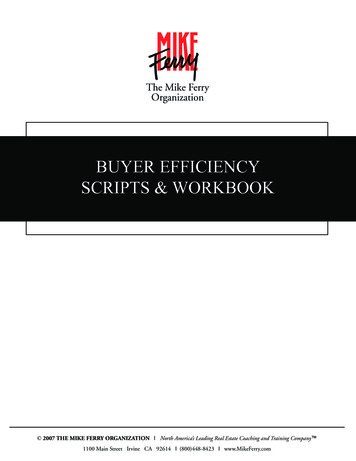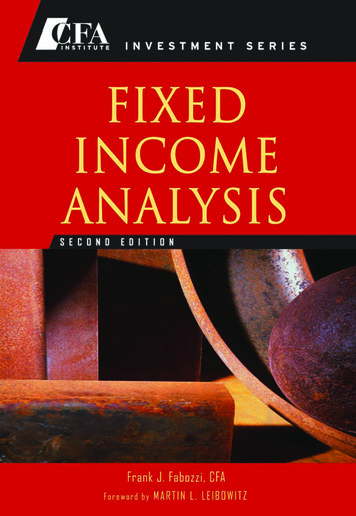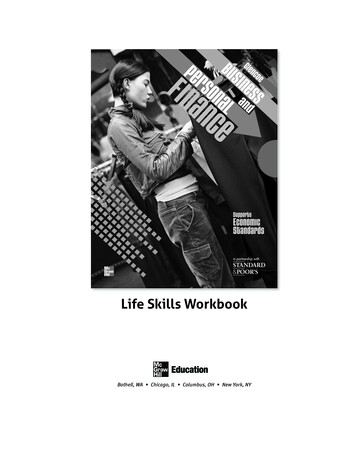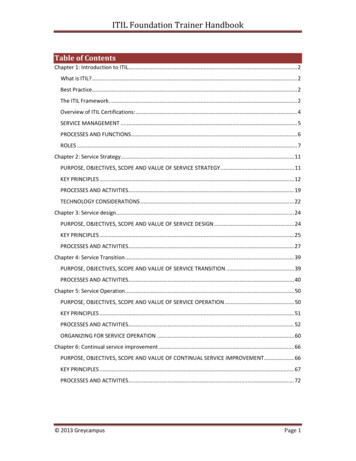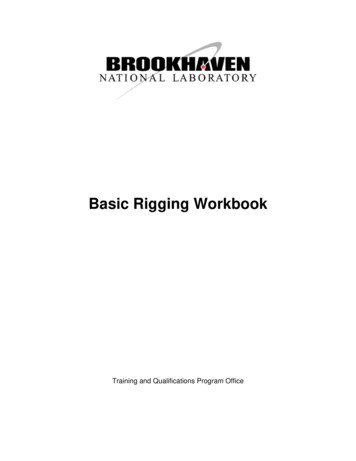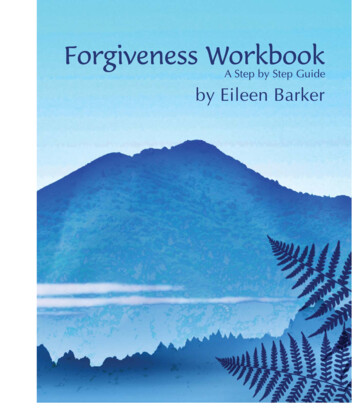
Transcription
ForgivenessWorkbookA Step by Step Guideby Eileen Barker
The Forgiveness Workbook 2009 by Eileen Barker.All rights reserved. Printed in the United States of America.Use of the material contained in this book for non-commercial purposes isencouraged provided that The Forgiveness Workbook by Eileen Barker isacknowledged as the source. Otherwise, no part of this book may beused or reproduced without written permission.ISBN 0-9702088-3-9Dialogue Press, PO Box 657, Westport, CT 06881-0657For information contact:Eileen Barker, 175 N. Redwood Drive, Suite 295, San Rafael, CA 94903.www.barker-mediation.comCover artwork by Terry BarkerGraphicon Designwww.graphicondesign.comInside design by Vicki KaufmanBlue Heron Design Studiowww.blueherondesignstudio.com
Dedicated toJohn Bern Ford,for leading me to the path of forgiveness,andmy son, Matthew Ryan Barker,for reminding me when I need to forgive.
If you let go a little, you will have a little happiness.If you let go a lot, you will have a lot of happiness.If you let go completely, you will be free.Ajahn Chan
AcknowledgementsMuch of the material contained in this Forgiveness Workbook is anintegration of what I have learned from others. I want to acknowledgethese individuals and others who have played a special role in my journey offorgiveness: Fred Luskin, Ph.D., author of Forgive for Good and Forgive for Love, forhis pioneering research and teaching in the field of forgiveness. Dr.Luskin has set forth an invaluable structure for understanding howgrievances are formed and how they can be transformed. His definingwork has directly informed much of the process contained in thisworkbook. For more information, see www.learningtoforgive.com, Kenneth Cloke, author of Mediating Dangerously and numerous otherbooks, for boldly teaching mediators and other conflict resolutionprofessionals that conflict is an opportunity for transformative healingand growth, and that emotions and forgiveness are integral parts ofresolving conflict. Robert W. Plath, founder and director of the Worldwide ForgivenessAlliance and International Forgiveness Day for his work and devotion topromoting the practice of forgiveness worldwide. Dana Curtis, a pioneer in teaching forgiveness, for generously sharingher materials and encouraging me to begin teaching forgiveness. Peter Rengel, spiritual teacher and author of Living Life in Love andSeeds of Light, for showing me the fearless path of love and letting gofor over twenty years. The late great Stan Dale and the Human Awareness Institute for helpingme create the life of my dreams. JoAnne Kellert, business coach, for insisting that I write this workbook!
Table of ContentsIntroduction . . . . . . . . . . . . . . . . . . . . . . . . . . . . . . . . . . . . . . . . . . . . . . . .1Part One:Understanding Forgiveness . . . . . . . . . . . . . . . . . . . . . . . . . .7Chapter 1: An Overview: Three Levels Of Forgiveness . . . . . . . . . .8Chapter 2: What It Means To Forgive . . . . . . . . . . . . . . . . . . . . . . . .14Chapter 3: Why Should I Forgive? . . . . . . . . . . . . . . . . . . . . . . . . . .17Chapter 4: Is It Possible To Forgive In This Situation . . . . . . . . . . . .20Chapter 5: How Do I Learn To Forgive? . . . . . . . . . . . . . . . . . . . . .22Part Two:The Forgiveness Process . . . . . . . . . . . . . . . . . . . . . . . . . . .23Step 1:Preparation . . . . . . . . . . . . . . . . . . . . . . . . . . . . . . . . . . . .24Step 2:Describe Your Situation . . . . . . . . . . . . . . . . . . . . . . . . . . .26Step 3:Deconstruct Your Story . . . . . . . . . . . . . . . . . . . . . . . . . . .28Step 4:Consider The Impact? . . . . . . . . . . . . . . . . . . . . . . . . . . . .32Step 5:Listen to Your Emotions . . . . . . . . . . . . . . . . . . . . . . . . . . .34Step 6:Shift Perspective . . . . . . . . . . . . . . . . . . . . . . . . . . . . . . . .40Step 7:Are You Ready To Forgive? . . . . . . . . . . . . . . . . . . . . . . . .43Step 8:Look for Positive Intention . . . . . . . . . . . . . . . . . . . . . . . .45Step 9:Forgive Yourself . . . . . . . . . . . . . . . . . . . . . . . . . . . . . . . .47Step 10: Rewrite The Story. . . . . . . . . . . . . . . . . . . . . . . . . . . . . . .50Step 11: Integration . . . . . . . . . . . . . . . . . . . . . . . . . . . . . . . . . . . .53Step 12: Completion . . . . . . . . . . . . . . . . . . . . . . . . . . . . . . . . . . . .54Recommended Websites. . . . . . . . . . . . . . . . . . . . . . . . . . . . . . . . . . . . .57Recommended Reading . . . . . . . . . . . . . . . . . . . . . . . . . . . . . . . . . . . . .58About the Author . . . . . . . . . . . . . . . . . . . . . . . . . . . . . . . . . . . . . . . . . . .59
IntroductionMy introduction to forgiveness came unexpectedly during a visit to WashingtonD.C. in 2005. Looking for something to read in the guest room where I was staying, Icame across the autobiography of Nelson Mandela, entitled Long Walk to Freedom. Istarted reading it one evening, and found that I simply could not put the book down. Init, Mandela tells the riveting story of his life and of the ending of apartheid in SouthAfrica. Through his eyes, I came to understand more fully the horrors of apartheid, asystem of institutionalized racism and white domination. When Mandela becamePresident of South Africa, he was urged by many to convene criminal tribunals to holdapartheid leaders accountable and gain retribution for the atrocities committed underthe apartheid government. Mandela understood that retribution would only perpetuatethe cycle of hatred and violence between the races, which South Africa could ill afford.Instead, Mandela courageously established the Truth and Reconciliation Commissionas a vehicle to promote truth telling, forgiveness and healing.Realizing the enormity of Mandela’s choice was a life changing moment for me. Itled me to closely study the incredible life and teachings of Mohandas Ghandi, one ofMandela’s role models. It also led me to Archbishop Desmond Tutu’s wonderful bookNo Future Without Forgiveness which further reveals the crimes committed in the nameof apartheid and the miraculous examples of forgiveness which emerged from the Truthand Reconciliation Commission hearings. One that I find incredibly inspiring is the storyof the Biehl family.1
Amy Biehl was a Fulbright scholar from California who had been involved in ananti-apartheid student campaign at Stanford University. She was living in South Africain 1993, working to help disadvantaged youths in the Gugulethu township. One day,while riding to the township, four young men stoned the car. When Amy got out of thecar, she was stoned and stabbed to death. In No Future Without Forgiveness, Tutuwrites:She who was so committed to justice was ironically killed by people whosecause she had espoused . . . Her family was obviously shattered. Yetinstead of being embittered and seeking revenge, quite remarkably theydid not oppose the amnesty applications of those who had killed their childso brutally. Mr. Peter and Mrs. Linda Biehl attended the amnestyapplication hearing and said that they supported the entire process ofreconciliation and amnesty. They embraced the families of the murderersof their child.But what is more remarkable is that they have established the Amy BiehlFoundation with the objective of uplifting the youth in the very townshipwhere their daughter was killed, helping residents who could very wellhave been involved in Amy’s murder. The Biehls return to South Africaregularly to oversee the operations of the foundation and they frequentlypass the spot where their child met her gruesome death.As profound as the Biehl story is, what I find most amazing is this: Two of theyoung men who killed Amy Biehl later went on to work for the foundation established byher parents, helping other troubled youth in their township. They came to adopt Amy’slife mission as their own.2
These stories and many more like it have inspired me to learn aboutforgiveness, practice forgiveness in my own life, and teach it to others. Theyspeak to the greater possibilities that exist in life, if we are willing to openourselves to them.Against this backdrop, I often reflect on the sorts of conflicts that I haveencountered over the past 30 years as a lawyer and mediator: conflicts betweenlarge and small businesses, corporations, partners, neighbors, employers andemployees, doctors and patients, lawyers and clients, coworkers, spouses, andfamily members. I have observed how consuming and debilitating conflict is formost people. I have watched clients go through years of litigation, only to win avictory that seemed quite hollow compared to the time, money and energy spentin achieving it. This has led me to embrace mediation which I believe uniquelyoffers people the opportunity for healing and true resolution of conflict. Yet, evenin mediation, I have seen many people settle their legal dispute, only to continuemistrusting and hating those on the other side.Above all, I have seen how our legal system and popular culture glorifyadversity and encourage blame and retribution. Rarely do we consider the pricewe are paying for those attitudes, or the greater possibilities offered from truth,healing and forgiveness. Eventually, I hope that we will find a place in our cultureand legal system for embracing forgiveness. It is only through forgiveness thathealing and wholeness can occur.3
Indeed, one of the most powerful choices we can make is to forgive those weperceive to have injured or wronged us in some way. At its essence, forgivenessis a decision to let go of the past, including our feelings about injury and harm thatoccurred in the past. It doesn’t mean we condone what happened. It meanswe’ve decided to move on from it. Forgiveness is choosing to reclaim your lifeand your energy, so you can live fully and freely in the present moment.Life is challenging. We encounter a wide array of difficult experiences in ourlives: dishonesty, disappointment, heartbreak, betrayal, job loss, humiliation,financial loss, illness, disability, abuse, violence, war, death . . . the list is endless.The pain and suffering are real.The suffering of life can be enormous, and the pain almost unbearable. As weencounter loss, we often develop strategies and defense mechanisms which enable usto avoid feeling the pain. One of them is to move, often automatically, into a position ofblame. We attempt to displace our pain onto the other person by saying (or thinking)“It’s your fault that this has happened” or “I am right, and you are wrong.” We want tohold the other person accountable. In the face of hardship, blame seems to providepsychological relief, and our entire culture not only endorses blame, but in many waysencourages and rewards it.The problem is, blame doesn’t work. It is a dead end. It may providetemporary satisfaction, but it doesn’t alleviate the problem. The underlying painremains, and is actually prolonged. As we attempt to shift pain onto the otherperson, we reinforce our own. We continue to focus on the painful experienceand on the past. We feel angry and hurt. We feel powerless and victimized. We4
believe we have the right to be angry, seek revenge, and/or feel sorry forourselves. Over time, we perpetuate our own suffering, but we don’t know whatelse to do.Forgiveness breaks the cycle. It enables us to let go of our grievances, and thepain associated with past events. Forgiveness can release us from a life time of painand liberate us from continuing to carry the burdens of the past. Forgiveness restoresus to peace, freeing us to move forward in our life.The idea of forgiveness is not new. Most of us learned about forgiveness aschildren, and depending on our upbringing, received countless messages from parentsand religious teachers about the importance of forgiving others. Yet, experience showsthat it is difficult to forgive, even if this is something we want, and often the truth is weoften don’t want to forgive, or don’t know how.Our inability to forgive costs us dearly. As we focus on ways that we believe wehave been harmed by others, we remain locked a prison that is created of our ownmaking, constructed with negative thoughts and emotions from the past. As wecontinue to experience blame and resentment, we suffer emotionally and physically.We miss the opportunity of being free and fully alive in the present.When I started teaching about forgiveness, I noticed that the same sorts ofreservations and questions about forgiveness would inevitably crop up: “If I forgive,wouldn’t it mean that I approve of what the other person did? After what was done tome, I’m entitled to feel angry and resentful. Why should I forgive?” These questionsand beliefs can be summarized in four central questions, which will be addressed inPart One of this workbook:5
1. What does it mean to forgive?2. Why should I forgive?3. Isn’t what happened to me unforgivable?4. How can I learn to forgive?In the end, what most people really want to know is: “Can I do this? Can this beapplied to my situation?” The short answer is “Yes.” Anyone can learn to forgive. Atany time. In any situation.Which brings us to: “Where do I begin?” Part Two of this workbook provides thehow. It is designed as a self-guided step by step process that will enable the reader towork through any situation or conflict in which there is a desire to forgive.6
PART ONEUnderstanding ForgivenessWithout forgiveness there is no future.Archibishop Desmond Tutu7
CHAPTER 1An Overview: Three Levels of ForgivenessForgiveness is not an occasional act. It is a permanent attitude.Martin Luther King, Jr.Discussion of forgiveness takes place on many different levels, but mostly focuseson forgiveness of others. However, there are in fact three distinct levels of forgiveness:Level One – Forgiveness of OthersThe first level is forgiveness of others. Often when we speak of forgiveness, it isassumed that we mean forgiveness of another person. This level seems to be the oneon which most people focus.“The Sunflowers” by Simon Wiesenthal is a poignant book about forgiveness ofanother person. Wiesenthal was a prisoner in a Nazi concentration camp and, after thewar, he become a prosecutor of war crimes. The book is about something extraordinarythat happened to Wiesenthal when he was in the camp. One day, as part of his workduty, he was taken to a nearby village and brought to the hospital room of a Nazi officer.He was told by a nurse that the Nazi officer was on his deathbed and had asked to talkto a Jewish person before he died. Wiesenthal was brought to the bedside to fulfill thisrequest, and the Nazi officer proceeded to make a confession that went on for severalhours during which he confessed to the many horrific things he had done to Jews duringthe war. At the end of this confession, the Nazi officer asked Simon Wiesenthal for his8
forgiveness. Wiesenthal was dumbfounded. Eventually, he got up and left the roomwithout saying anything.Thirty years later, Wiesenthal wrote about this experience and he posed a simplequestion to thirty theologians from around the world, including the Dalai Lama andArchbishop Desmond Tutu. He asked each of them: “What would you have done?”“The Sunflower” is a fascinating compilation of the essays written by these theologians.The perspectives shared are extremely thoughtful, heartfelt, well written, and all overthe map. Interestingly, one writer noted that the Christian writers tended to be in favorof forgiveness, based on the clear teachings of Christ, whereas the Jewish respondentswere equally adamant that it was not appropriate to forgive in this situation. Thisunderscores that how we feel about forgiveness is largely based on what we have beentaught and our belief system.Interestingly, all of the essays focused solely on whether one person should orcould forgive another. None explored the question of self-forgiveness. Yet, what struckme was that even if Wiesenthal had forgiven him, the Nazi officer would still have beenleft with his own substantial shame and remorse. The deepest layers of suffering stemfrom self-judgment about the ways we have fallen short.At the level of forgiving others, there is another type of forgiveness that is veryimportant. This is forgiveness for impersonal acts, acts that are not attributable to anyone individual, but that nevertheless can have a profound impact on our lives. Thiscould include forgiveness of mankind for destroying the health of the environment,forgiveness of God for allowing so much suffering to occur, forgiveness of “the system”or the government for being inefficient and corrupt, and forgiveness of society for being9
unwise and unfair. There are many ways in which the collective conduct of these typesof entities has a huge impact on our lives and can leave us feeling powerless. In theface of this, forgiveness is a very important and powerful way to reclaim our power andfind peace.Level Two – Self-ForgivenessFor closure to occur, there has to be both forgiveness of the other person andforgiveness of ourself. Even in situations in which we perceive ourselves to be thevictim, eventually we must forgive ourselves for any way in which we have contributedto our suffering, or the suffering of another.Because we usually start out feeling victimized by another person, it may bedifficult to see how or why we would need to forgive ourselves. However, as we movepast our anger and blame, there is often a realization that we too had a part in creatingthe situation. At the very least, we created our story about the situation, and keptreplaying it in our minds, which caused us to suffer. It may well have caused others tosuffer as well. Ken Cloke takes this a step further, making the point that the true sourceof every conflict is within our own minds:Most conflicts are triggered by external experiences and informationregarding them is conveyed to us by sensory inputs that have beengathered from our environment. Our conflicts therefore seem to us to takeplace externally, yet everything we understand about the meaning of whathappened, and all of our responses to the actions of other are initiated andcoordinated internally by our brains.10
Once we make the leap of understanding that it is the meaning we attach to eventsthat have caused our pain and suffering, rather than the external events themselves, theneed for self-forgiveness becomes apparent. The realization that we have created thevery problem for which we were accusing another can be humbling to say the least, andliberating, because now we have the power to end it.Jaimee Karroll, designated a Hero of Forgiveness by the Worldwide ForgivenessAlliance, forgave the men who kidnapped her as a child and sexually abused andtortured her. She came to the realization that she also needed to forgive herself:I had no idea how my life would be reshaped when I was finally able toconsider the possibility of trying to forgive myself. I began to realize that Iwould have to look at how my rage and despair had resulted in hurt tothose who loved me the most: my husband, family members and friends.From there, it was not difficult to recognize that if I was going to forgivemyself for hurting others, then I ought to consider forgiving those who hadhurt me. Forgiveness was not achieved in a single moment, but hasunfolded over two decades.Thus, although Karroll was clearly a victim of a terrible crime, she bravely came tosee that she herself had also caused suffering. More importantly, she realized thatwhile she could do nothing to undo past events, she alone could stop the suffering thatshe was perpetuating. This became the basis of her self-forgiveness.Without self-forgiveness, we continue to inflict emotional pain on ourselves andthose around us. We may harbor harsh judgments against our self. In the earlystages, if we are focused on blaming the other person, these self judgments, may besubtle or even unconscious. However, they will eventually surface, and take their toll,eroding one’s sense of well-being. The only release is through self-forgiveness.11
Level Three – There Is Nothing To ForgiveThe third level of forgiveness is the most controversial. It is the realization that, atthe deepest level of understanding, there is nothing to forgive. It asks us to consider thepossibility that at some level everything is exactly as it is intended to be, even thoughwe may not like or understand it. It challenges us to let go of our notions of right andwrong, and the belief that we know how life is supposed to be, and how people shouldor should not behave. It challenges us to humbly admit that we do not know themeaning of life or the bigger picture of what is occurring in any given situation. If wecan shift our perspective to see that life is occurring exactly as it is meant to occur, thenthere is nothing to forgive.Along these lines, teacher and author Byron Katie says our suffering is caused byour unexamined judgments and, specifically, the belief that someone has donesomething ‘wrong.’ She urges us to move beyond our preconceptions, rather thanaccept them automatically as true, and in so doing embrace the freedom of notknowing:Until you can see that there is nothing to forgive, you haven’t reallyforgiven. No one has ever hurt anyone. No one has ever done anythingterrible. There’s nothing terrible except your uninvestigated thoughtsabout what happened. So whenever you suffer, inquire. Look at thethoughts you’re thinking, and set yourself free. Be a child. Start from themind that knows nothing. Take your ignorance all the way to freedom.Similarly, in Power v. Force, author David Hawkins notes: “All pain and sufferingarise solely from the ego.” Hawkins cautions that our egoic thoughts are nottrustworthy. Nevertheless, we are easily beguiled by them. Hawkins beckons us to a12
level of self-awareness that can perceive the egoic thoughts without being pulled alongin their wake: “The great tragedy of human life has always been that the psyche is soeasily deceived.”As we develop the ability to unhook ourselves from our ego, it becomes possible toembrace a profound acceptance of life as it unfolds. A wonderful example of this isJulie Chimes, who was also honored as a “Hero of Forgiveness” by the WorldwideForgiveness Alliance. One day, a woman visiting Julie’s home suddenly took a carvingknife from Chime’s kitchen and began a frenzied attack, stabbing Julie and leaving herclose to death. Chimes later reported that in the moment when she was been attacked,a part of her was witnessing all that was occurring and had compassion for the womanattacking her:I am neither christened nor religious but Christ’s words about “Fatherforgive them for they know not what they do” is the closest way to describehow I felt. As I blamed no one, there was nothing to forgive, but there wasstill a lot for me to learn and understand. . . . I now know when there isunderstanding there can be compassion. When compassion arises therecan be forgiveness. Where there is forgiveness there is peace.It is possible even in the midst of great trauma to accept what is, realize that noone is to blame, and see there is nothing to forgive. This requires us to transcend ourpersonal plight. It requires us to identify with a part of our self that is bigger than ourego, our fear, and our pain. If we are able to achieve this, the rewards are profound.As we accept life, as it is, we are free to flow with the current, rather than against it.Inevitably, we find life’s greatest treasures in the midst of what may have at firstappeared to be a tragic situation.13
CHAPTER 2What it Means to ForgiveForgiveness means letting go of the hope of ever having a better past.Course in MiraclesIn the context of the first level of forgiveness, the forgiving of another person,people often get stuck in misunderstandings about what it means to forgive. It isimportant to clarify what forgiveness is, and what it is not.Forgiveness is a decision not to pursue resentment or revenge. It means letting goof our claim of wrongdoing, the desire to blame, and the need to be right. It meansletting go of the past and seeing oneself as a victim. Forgiveness means creating anew story about what occurred which is both peaceful and self-empowering. Correctlyunderstood, forgiveness means putting your attention back on yourself rather than onthe other person, and reclaiming a sense of inner peace and love.One of the greatest myths about forgiveness is that it is done for the benefit of theother person. Forgiveness is not for the other person’s benefit. It is for your ownbenefit. To understand this fully, you must realize how much you hurt yourself by notforgiving. Then, you can appreciate that forgiveness is one of the most divinely selfishactions a person can ever take.Fred Luskin, author of Forgive for Good and Forgive for Love, is one of the world'sleading researchers and teachers on the subject of forgiveness, and the director of theStanford Forgiveness Project, which conducts research on forgiveness methods.Luskin provides the following distinctions (partial list):14
What Forgiveness Is: Forgiveness is taking back your power. Forgiveness is taking responsibility for how you feel. Forgiveness is for you and not the offender. Forgiveness is about your healing and not about the people who hurt you. Forgiveness is a trainable skill. Forgiveness is becoming a hero instead of a victim. Forgiveness is a choice.The last point is most significant: forgiveness is a choice. Every one of us has thepower to forgive and can exercise that power as we alone see fit. Forgiveness does notdepend on what anyone else does. It's something you do for your own benefit, not foranyone else. We can choose to forgive, or choose not to forgive, and we alone mustchoose the timing. It is essential that each person’s choices be completely honored.As Holocaust survivor Viktor E. Frankl points out, no one can force another person toforgive, nor can anyone stop us from forgiving.We who lived in the concentration camps can remember those whowalked through the huts comforting others, giving away their last piece ofbread . . . They may have been few in number but they offer sufficientproof that everything can be taken from us but the last of human freedoms. . . the freedom to choose our spirit in any circumstance.15
What deters many people from pursuing forgiveness is the mistaken idea thatby forgiving, they will somehow be condoning or approving conduct which theyperceive to be wrongful. According to Luskin:What Forgiveness Is Not: Forgiveness is not condoning unkindness. Forgiveness is not forgetting that something painful happened. Forgiveness is not excusing poor behavior. Forgiveness does not have to be an otherworldly or religious experience. Forgiveness is not denying or minimizing your hurt. Forgiveness does not mean reconciling with the offender. Forgiveness does not mean you give up having feelings about what occurred.What is most important is understanding that forgiveness is not forgetting,condoning, excusing, or saying that hurtful conduct is okay. Also, it doesn’t have to belinked to any particular religious belief or practice. Most important is that forgivenessnot be seen as obligatory. Rather, it is a choice.One further note: forgiveness is not the same as reconciliation. Reconciliationmeans forming a new relationship with the other person. Forgiveness is a necessaryprecursor to reconciliation: without forgiveness true reconciliation cannot occur. Yet, itis possible to forgive without reconciling. Remember, forgiveness has nothing to dowith the other person. You can forgive someone who has been dead for many years.You can forgive someone, yet chose to have no further contact with them.16
CHAPTER 3Why Should I Forgive?Forgive all who offended you, not for them, but for yourself.Harriet NelsonIn the face of stressful situations or relationships, we often seek to avoid the otherperson involved. Or we settle for an unspoken truce. The conflict is no longer openlyexpressed, but the tension remains. Family members stop talking to each other.Friends distance themselves. Co-workers avoid contact. The problem remains underthe surface, waiting for the next opportunity to erupt. Even if the conflict does notreemerge openly, we pay a price for the unspoken tension.Until we forgive, part of our attention is held in place by what we perceive to be theproblem. Some amount of our life energy is expended on it. A portion of our life energyis taken up with the problem, and is therefore not available to us for other, more positiveand creative endeavors.The benefits of letting go of difficult experiences from the past seem apparent.Why then, can it be so hard to forgive? According to Luskin, the primary issue is one ofhabit and motivation: “The hesitancy to forgive is principally a question of motivation . . .and our tendency to continue reacting to hurt in ways that do not work.”Our habits keep us stuck in certain patterns. Some people will develop negativethought patterns, obsessing about the other person and what occurred. Others willhave habitual emotional response, which may include long periods of depression.Some will develop feelings of hopelessness about the situation, and perhaps life ingeneral.17
Holding onto grievances is also physically debilitating. The research of Luskin andothers has demonstrated convincingly that conflict is hazardous to one’s health: Even thinking about an unresolved conflict causes the body to releasestress chemicals and respond in measurable, harmful ways. Simply recalling an event which triggers feelings of anger or resentmentincreases one’s heart rate and blood pressure. People who are chronically angry are at higher risk for heart attacks andother cardiovascular disease, as well as immunological weakness. Conversely, learning
anti-apartheid student campaign at Stanford University. She was living in South Africa in 1993, working to help disadvantaged youths in the Gugulethu township. One day, while riding to the township, four young men stoned the car. When Amy got out of the car, she was stoned and stabbed
